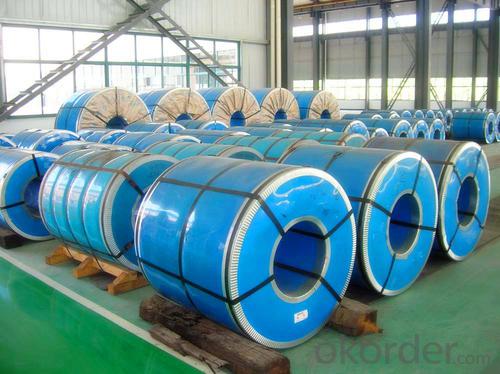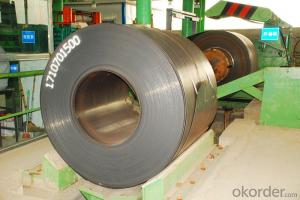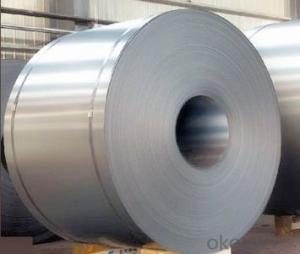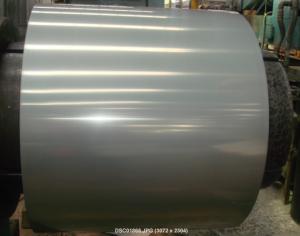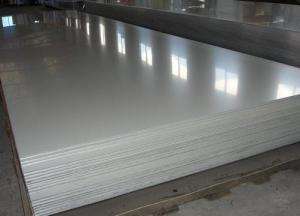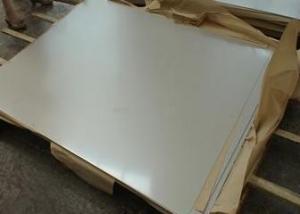Stainless Steel Coil 201 Hot / Cold Rolled Coil Narrow / Wide
- Loading Port:
- Lianyungang
- Payment Terms:
- TT OR LC
- Min Order Qty:
- 400 m.t.
- Supply Capability:
- 5000 m.t./month
OKorder Service Pledge
OKorder Financial Service
You Might Also Like
201 Hot Rolled Stainless Steel Coil Specifications
THK:2.3/2.5/3.0/4.0mm
Width:485/510/550/610/1010/1240mm
Face:No.1
201 Hot rolled stainless steel Coil Application
Stainless steel is a production which not easy rust,acid resistance and corrosion resistance,so it is widely
used in light industry,heavy industry,daily necessities and the decoration industry.
201 hot rolled stainless steel coil, use to produce cold rolled stainless steel coil and stainless steel tube, pipe.
201 Hot Stainless Steel Coil Chemical Composition(WT%)
(C):≤0.15, (Si):≤0.75, (Mn):5.5~7.50, (Cr):16.0~18.0, (N):≤0.25, (Ni):3.50~5.50, (P):≤0.060, (S):≤0.030
201 Hot Rolled Stainless Steel Coil
Strength Of Extension:100,000 To 180,000 Psi;
Yield Strength:50,000 To 150,000 Psi
Elongation :55 To 60%;
Modulus Of Elasticity:29,000,000 Psi;
Density :.280lbs/Cubic Inch(7.93g/Cm3)
- Q: What is the electrical conductivity of stainless steel strips?
- The electrical conductivity of stainless steel strips can vary depending on the specific type and composition of stainless steel. Generally, stainless steel is not as conductive as other metals like copper or aluminum. The electrical conductivity of stainless steel is typically lower due to its higher resistance to the flow of electric current. However, there are stainless steel alloys that have been specifically designed for improved electrical conductivity. These alloys often contain higher levels of elements like nickel or copper, which enhance the material's conductivity. It is important to note that the electrical conductivity of stainless steel can also be affected by factors such as temperature, surface condition, and thickness of the strip. Therefore, it is advisable to refer to specific data or consult with manufacturers for accurate information on the electrical conductivity of stainless steel strips.
- Q: Can stainless steel strips be used in chemical pumps?
- Yes, stainless steel strips can be used in chemical pumps. Stainless steel is highly resistant to corrosion and can withstand exposure to various chemicals. It is commonly used in the construction of chemical pumps and other equipment that comes into contact with corrosive substances. The use of stainless steel strips ensures the durability and longevity of the pump, making it suitable for handling different types of chemicals.
- Q: Can stainless steel strips be used in medical implants?
- Medical implants can utilize stainless steel strips, which are commonly used in the medical industry due to their exceptional corrosion resistance, durability, and biocompatibility. They are frequently employed in the production of medical devices such as surgical instruments and orthopedic implants. To meet the specific requirements of different medical implants, stainless steel strips can be shaped and sized accordingly. The material's ability to resist corrosion ensures its ability to withstand bodily fluids and harsh internal environments, consequently reducing the risk of implant failure or infection. Furthermore, extensive research and documentation have confirmed the biocompatibility of stainless steel. This means that it is well-tolerated by the human body and does not cause any adverse reactions. Thus, stainless steel is a secure and dependable option for medical implants, minimizing the chances of allergic reactions or long-term complications. Nevertheless, it is important to acknowledge that the choice of materials for medical implants ultimately relies on the particular application and the unique needs of each patient. Consulting with medical professionals and adhering to regulatory guidelines is vital in determining the most appropriate material for each individual case.
- Q: Are stainless steel strips non-magnetic?
- Yes, stainless steel strips are generally non-magnetic. However, the magnetic properties of stainless steel can vary depending on the specific alloy and its composition. The most common types of stainless steel, such as 304 and 316, are non-magnetic in their annealed state, meaning they do not attract or hold a magnetic charge. This makes them suitable for a wide range of applications where magnetism is not desired. However, some stainless steel alloys, such as ferritic grades, can exhibit magnetic properties due to their higher iron content. It is important to consider the specific type of stainless steel when determining its magnetic properties.
- Q: Can 111 stainless steel strips be passivated to enhance corrosion resistance?
- Certainly! Passivation can improve the corrosion resistance of 111 stainless steel strips. It involves removing iron from the surface and creating a protective oxide layer. This layer acts as a barrier, preventing further corrosion and increasing resistance to chemicals, moisture, and temperature. Industries such as automotive, aerospace, medical, and food processing commonly use passivation to enhance the longevity and performance of stainless steel components. Consequently, by passivating the 111 stainless steel strips, their corrosion resistance can be enhanced, resulting in improved durability and reliability for their intended applications.
- Q: What are the recommended storage conditions for 111 stainless steel strips?
- The storage conditions for 111 stainless steel strips are advised as follows: 1. Temperature: It is recommended to store the stainless steel strips in a controlled environment with a temperature range of 20°C (68°F) to 25°C (77°F). It is important to avoid extreme temperature changes, as they can cause thermal expansion or contraction, leading to potential warping or distortion of the strips. 2. Humidity: The ideal humidity level for storing stainless steel strips is around 50%. High humidity can promote corrosion, while low humidity can make the strips brittle. To maintain optimal conditions, it is advisable to store the strips in a dry location, away from sources of moisture. 3. Ventilation: Sufficient ventilation is crucial to prevent moisture accumulation or condensation on the stainless steel strips. Storing them in a well-ventilated area helps minimize the risk of corrosion and maintain the quality of the material. 4. Protection: It is important to shield the stainless steel strips from exposure to chemicals, corrosive substances, and direct sunlight. Storing them in a clean and dry environment, free from potential damaging contaminants, is recommended. Additionally, covering the strips with a protective layer, such as plastic or paper, helps prevent scratches or surface damage. 5. Organization: Proper organization and storage practices are essential to prevent damage and ensure easy access to the stainless steel strips. They should be stored horizontally, preferably on pallets or racks, to avoid bending or warping. Labeling each strip with relevant information, such as grade, dimensions, and manufacturing date, can facilitate efficient inventory management. By adhering to these recommended storage conditions, the durability and quality of the stainless steel strips can be guaranteed, minimizing the risk of corrosion, distortion, or other forms of damage.
- Q: Can 111 stainless steel strips be formed into seamless tubes?
- Indeed, it is possible to form seamless tubes from 111 stainless steel strips. Typically, the stainless steel strips undergo cold rolling, resulting in a circular shape, after which the edges are skillfully welded to achieve a seamless tube. This technique finds widespread application in the manufacturing industry, catering to diverse needs such as plumbing, automotive, and industrial purposes.
- Q: Can stainless steel strips be used for chemical reactors?
- Certainly! Chemical reactors can indeed utilize stainless steel strips. Stainless steel is widely preferred in the construction of chemical reactors owing to its exceptional resistance to corrosion, ability to withstand high temperatures, and overall durability. Its capacity to endure harsh chemical settings makes it an ideal choice for a diverse range of chemical reactions. When it comes to constructing reactors, stainless steel strips offer a flexible and economical solution as they can be effortlessly molded into desired configurations and dimensions. Additionally, stainless steel is simple to clean and maintain, guaranteeing the reactors' integrity while preventing any contamination during the chemical processes.
- Q: What industries use stainless steel strips?
- Several industries use stainless steel strips, including automotive, aerospace, construction, food processing, pharmaceutical, and chemical industries. Stainless steel strips are valued for their corrosion resistance, durability, and strength, making them suitable for applications such as automotive components, aircraft parts, building facades, kitchen equipment, medical devices, and various industrial machinery.
- Q: How do stainless steel strips perform in seawater environments?
- In seawater environments, stainless steel strips display a remarkable resistance to corrosion and perform exceptionally well. This is because they have a composition that includes a significant amount of chromium, which leads to the formation of a protective oxide layer on their surface. This layer acts as a barrier against corrosion, preventing direct contact between the steel and corrosive elements like salt and moisture in seawater. Moreover, stainless steel strips exhibit outstanding resistance to pitting and crevice corrosion, which are common types of corrosion in marine settings. This resistance can mainly be attributed to the high levels of chromium and nickel present in stainless steel. These elements enhance the steel's ability to withstand the aggressive nature of seawater, ensuring its durability and longevity. Another advantage of stainless steel strips is their versatility and adaptability, making them suitable for various applications in seawater environments. They can be easily formed, welded, and fabricated into different shapes and sizes, offering flexibility in design and construction. In conclusion, stainless steel strips are an excellent choice for use in seawater environments due to their exceptional resistance to corrosion, durability, and versatility. They provide long-lasting performance, require minimal maintenance, and can endure the harsh conditions associated with marine applications. Therefore, they are a reliable and cost-effective solution.
Send your message to us
Stainless Steel Coil 201 Hot / Cold Rolled Coil Narrow / Wide
- Loading Port:
- Lianyungang
- Payment Terms:
- TT OR LC
- Min Order Qty:
- 400 m.t.
- Supply Capability:
- 5000 m.t./month
OKorder Service Pledge
OKorder Financial Service
Similar products
Hot products
Hot Searches
Related keywords




